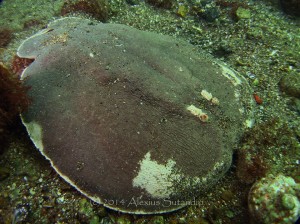I wrote an article about sighting a Numbfish, Hypnos monopterygium, at Semaphore Beach in our November 1991 newsletter (No.172). At the end of my article, I stated that I intended to write an article giving more details about the Numbfish for a future Newsletter. I’m not sure just what I had in mind, but I don’t believe that the proposed article ever eventuated. I am now able to rectify the situation since Alexius Sutandio found a Numbfish by accident at Whyalla during our recent Underwater Shootout there. Several Society members were diving at the “OneSteel rockwall” on the Queen’s Birthday public holiday Monday, including Alexius Sutandio. Alexius was the last diver to return to Tony Bramley’s boat. He casually advised us that he had had an encounter with a Numbfish during his dive. He later posted some details on Facebook, saying “It gave a good electric shock to my left elbow while I accidentally leant on its body on the sand where he was camouflaged.”
Alexius was in the process of photographing another subject at the time, but he soon turned his attention to the Numbfish. He was able to take this great photo of the fish: –
Numbfish, Hypnos monopterygium
(Taken by Alexius Sutandio)
Another posting by Alexius on Facebook said, “This Numb Ray pretty well camouflaged, I can’t see him first time I got shocked. All of the body covered with sand.”Graham Short added a comment, saying “I put my hand on one in Jervis Bay, really nice experience”.
Chris Hall found a Numbfish at the “Glenelg Barges” prior to 1999. His sighting was included in a list of fish sighted at the “Glenelg Barges” published in our January 1999 newsletter (No.251). Chris may have been able to photograph the Numbfish because a photo of one taken by Chris at the Dredge (Glenelg Barges) is included in our Photographic Index (No.1142).
Antony King was able to photograph a Numbfish at Seacliff Reef. A photo of the fish featured in our 2009 Calendar of SA Marine Life (November 2009 small). As a result of that, the photo was also included in our Photographic Index (No.1434).
Peter Harman found a Numbfish whilst walking on the beach at Brighton one morning. Realizing it was still alive after getting a small shock, he got a pair of welding gloves and a bucket to put the numb fish in and he took it home to put it in an aquarium that he had. It survived in the aquarium for a month or so. Details were published in our November 1983 newsletter.
The article in our November 1991 newsletter about my Numbfish sighting at Semaphore beach quoted both “Sea Fishes of Southern Australia” and “The marine & freshwater fishes of South Australia”.
“Sea Fishes of Southern Australia” referred to electric fishes on page 16. It said that “The two electric rays, or numbfishes, covered in this book are capable of producing an electric shock when touched, both in and out of the water. The larger Numbfish inhabits shallow waters and is often accidentally trodden on. The resulting shocks may cause temporary paralysis of the limb. Several shocks can occur before the fish is completely discharged, the first usually being around 200 volts. The charge can be restored relatively quickly. The ability to deliver these shocks is used to obtain food as well as for defence.”
“The marine & freshwater fishes of South Australia” referred to electrical injuries on page 355. It said that, “Only moderate shocks have been recorded, without however, harmful after-effect.”
The newsletter article went on to describe three numbfish species – Numbfish, Tasmanian Numbfish and the Torpedo or Electric Ray (a deep-water species).
Wolfgang Flachsenberger wrote an article titled “The Electric Organs in Fishes” which was published in our November 1979 (MARIA) Journal (No.2). Five references were listed at the end of the article. Chris Illert provided a group of drawings, plus a graph, for the article. The graph was of the “maximum output voltage plotted against the total number of electroplates in several varieties of fishes”.
I found several references regarding electric fish (fishes?) and numbfish amongst my book collection and our Society’s library books. Some of these books are: –
“Animal Physiology” by Knut Schmidt-Nielsen
“Marine Animal Injuries to Man” by Dr Carl Edmonds
“Guide to Sea Fishes of Australia” by Rudie H Kuiter
“World Atlas of Marine Fishes” by Rudie H Kuiter & Helmut Debelius
“Australian Sea Fishes – South of 30°S” by Neville Coleman
“Australia’s Dangerous Creatures” – Reader’s Digest
“Evolution – The greatest story ever told” by Philip Whitfield
“Danger in the Sea” by Alec Fraser-Brunner
“Coastal Fishes of South-eastern Australia” by Rudie H Kuiter



I can vouch for the shock from what we thought was a stranded stingray. Big jolt that felt like it came out the back of my shoulder. Took about half an hour before the effects wore off.
Thanks for your comments, Chris. These details all add to our knowledge of the species.